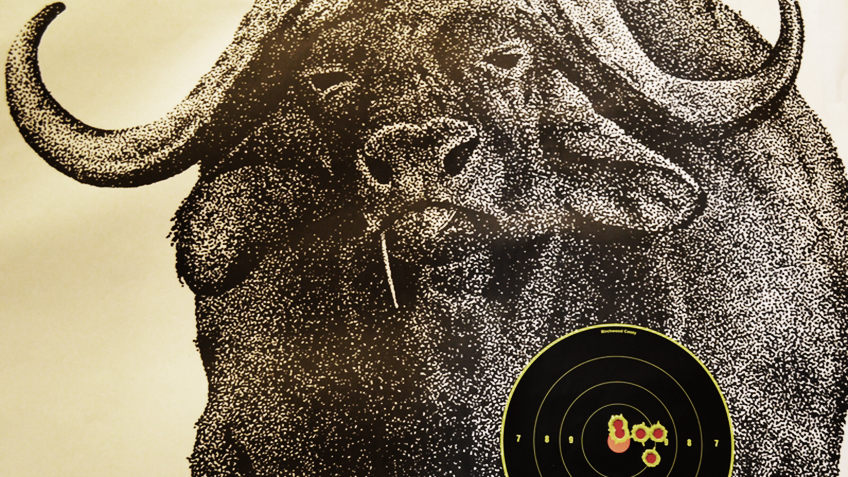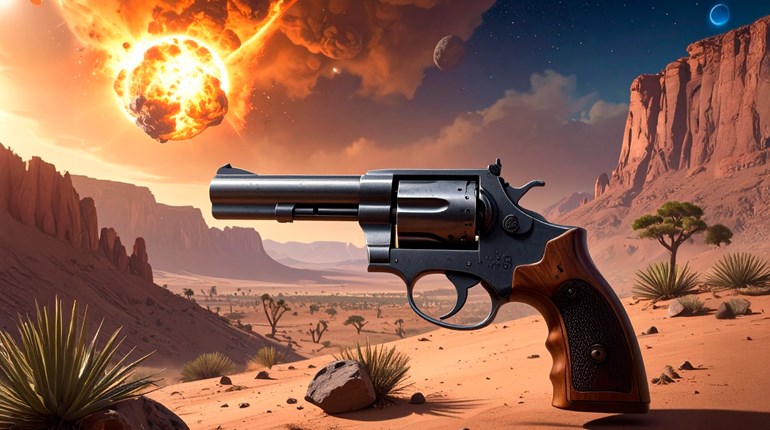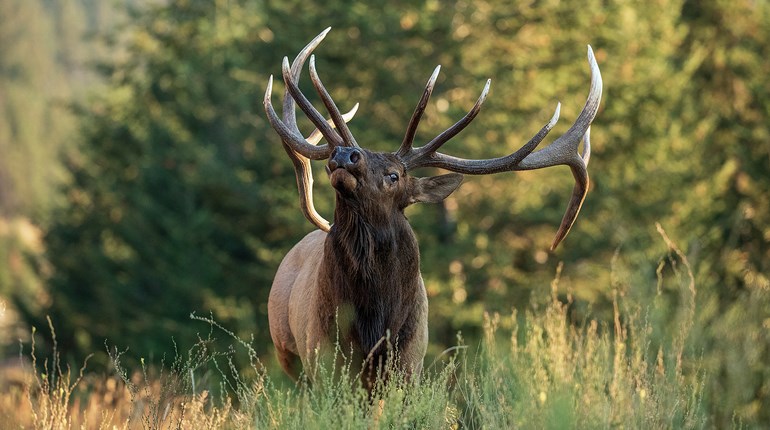
This is an old scheme that got derailed a few years ago. The plan was to take the long ride to the Dark Continent and tag a Cape buffalo with a relatively miniscule handgun. My professional hunter's health problems sidelined that hunt, forcing me to change hunting destinations to South America where a water buffalo was dispatched with a .480 Ruger Super Redhawk. We are back on track now, and hopefully the health of everyone involved will remain stable. Fingers crossed.
To recap, yours truly is scheduled to fly to the Eastern Cape of South Africa to hunt Cape buffalo with a revolver, an idea hatched by myself and American Hunter Editor in Chief Scott Olmsted over entirely too much sake (not an unusual idea in Max’s decision making paradigm). That was the plan, requiring suitable preparation for the task ahead.
I started by contacting Tollie Jordaan of Tollie’s African Safaris at the suggestion of Scott. That I wasn’t rejected outright when I told Tollie I would be using a revolver on Cape buffalo either meant he was unfazed by the prospect or he didn’t quite hear me. A plan was hashed, dates were chosen and the ball was rolling and rapidly picking up speed.
When I got confirmation that the hunt was a go, I jumped into action despite the year-long (emphasis placed squarely on long) wait that would ensue. Now that the plan was set in motion, we had to decide on what firearms we would be using for the monumental task at hand. Yes, I said firearms, plural, as I intended to hunt some plains game while there.
Tools for the Task
Since this was a handgun hunt, I sought two different “types” of revolvers, separated by two differing tasks: dangerous game and plains game. However, either revolver would be able to cover the other’s main role if need be. I had originally intended to use a Magnum Research BFR in .444 Marlin for the plains game portion of the hunt. This is one of Magnum Research’s long-framed offerings that I had equipped with a 10-inch barrel—to more fully take advantage of the rifle cartridge—and their excellent Bisley grip frame. I found the .444 to be finicky in that virtually every factory ammunition offering was developed for use in a rifle, with a long barrel and a closed breech. It was proving an uphill battle and I didn’t have the time or inclination to handload for yet another caliber. I wanted something more turn-key. However, I did find one load that performed well—a 270-grain soft-point by Buffalo Bore Ammunition. What I didn’t count on was the difficulty I was experiencing with this somewhat unwieldy combination that I had equipped with a fixed 4X Leupold handgun scope. This was the ideal candidate for fixed position stand or blind hunting, but less than ideal for quickly throwing up on sticks or hasty field positions on the fly. I was having a devil of a time fighting with the behemoth.

Then I was hit with some unfortunate news; I received a call from the nephew of Dick Casull informing me that Dick had passed away after a long battle with cancer. My choice then became crystal clear, I would call Magnum Research and order one of their fine revolvers in .454 Casull. It was the most logical choice for the task at hand. The .454 is a relatively flat shooting (as far as revolver rounds are concerned), hard-hitting round that fits in the confines of a gun of “normal” proportions. This is not an indictment of the long-framed BFR, but when equipped with a 10-inch barrel, it was simply the wrong tool for this particular job. I would equip this 6 ½-inch barreled revolver with the same 4X Leupold optic attached with Leupold’s excellent quick-detach rings on the Magnum Research supplied scope base.

My first choice in factory ammo was simple. I had a couple of requirements dictating the choice. The load would have to shoot flat out to 100 yards, and it would have to use a tough expanding bullet that opens moderately, but penetrates deeply as there would be lightweight and more moderately sized animals on the menu for this hunt. Federal’s 300-grain Swift A-frame loads fit the bill perfectly. I had used this accurate load in the past on whitetail and was confident in its performance. In the new BFR I was greeted with goodness, the gun/load combination delivering exceptional accuracy, and the Swift A-frame is a great choice for both lighter-skinned fare as well as heavy-boned big-game animals.

Dangerous game, in this case Cape buffalo, would be tackled with a BFR in one of my favorite calibers, the .500 JRH, essentially a shortened (the case is 1.4 inches in length) .500 S&W Magnum. This one was fitted with a 5½-inch barrel, and a Bisley grip frame. I attached the factory scope base to the revolver with a liberal slathering of red thread lock. Leupold steel 30mm rings would be tasked with holding the Ultradot Four red dot sight tightly to the revolver. I used the Leupold Mark 4 rings—the 30mm Medium steel units, SKU No. 61049. I really like red dots; they’re easy and fast to acquire with practice, they’re great in low-light and Ultradot sights are just tough and really hard to hurt.

I was using a handload consisting of Starline brass, CCI 350 primers, and a Kodiak Punch bullet over a stiff charge of 296. The bullet is mostly brass in construction with a lead insert to give it some weight, and a rather large flat nose (meplat), ensuring deep, straight-line penetration and a large permanent wound channel. These bullets tip the scale at 420 grains and I was pushing them right around 1400 fps. I had the opportunity to put my entire bullet/revolver/optic combination to the test at Action Outdoor Adventures of Hondo, Texas, on a particularly large and ornery water buffalo. The load performed admirably, starting with a chest shot that center-punched the big bull’s heart and it was all down hill from there. The test can be seen on YouTube by clicking here.

Let’s talk bullets for a moment. Revolvers don’t generate velocity levels anywhere near even the most sedate rifle rounds (excluding some old black-powder cartridges), so bullet choice is paramount—not that it isn’t with rifle cartridges as well—it’s just that handgun hunters can ill afford to leave anything behind when it comes to bullet design. Starting out at a half-inch in diameter (in the case of my .500 JRH), expansion is not only unnecessary, but also unwanted. Anything, like expansion, that can potentially hinder penetration on an animal the size of Cape buffalo should be avoided like the bubonic plague. This is why I chose the Kodiak Punch bullet. The Kodiak Punch isn’t cheap, but neither is the trophy fee of the Cape buffalo, nor the flight half-way around the world, nor is your life for that matter. This is one place you should never cut cost.

The .500 would be carried in a custom shoulder rig by Graveyard Jack’s Custom Sixgun Leather done in elephant leather. I complemented the holster with a matching elephant leather belt by Bullhide Belts, to not only hold my pants up, but to hold two cartridge slides, also by Graveyard Jack. The .454 would ride in a Galco Kodiak Hunter shoulder holster actually made for a Ruger Super Blackhawk with an optic. The short-framed BFR is close enough dimensionally to work well with this holster.

Another important decision to make when traveling long distances with firearms is gun case choice. On my last international hunt, I used a case by Negrini. It was thin, but not frail, with plenty of space that got my equipment to South America and back unharmed. I opted to again use a Negrini case that was perfect for housing my two revolvers, my spare optics, a pair of binoculars and a laser range finder. Made from Negrini’s patented double wall ABS plastic, the case is not only tough, but sleek, elegant and TSA approved. It also features two steel combination locks, the two sides separated by a padded divider and featuring die cut “pluck-n-pull” foam allowing you to customize the case for your individual application.

Another feature I really found not only useful, but attractive, was the compact size of the case. Unlike some cases, at only 24 inches in length, it’s small enough not to draw attention to its contents. As a handgun hunter, I go to great lengths to safely transport my firearms. I, like you, have a lot riding on my guns arriving to their destination intact. Judging by the condition my cases sometimes arrive, I often wonder if the neglect and outright mistreatment of the case and the resulting external damage is deliberate. Often my other bags arrive unscathed, yet my gun case has scratches, dings and other damage that defies logic. This is where that second function comes into play—knowing that even if the airline employs King Kong to handle the baggage, your guns will arrive unscathed. Just another piece of insurance to ponder.
Practice, Practice, Practice and Practice Some More
My practice regimen borders on the obsessive. Once my bench work is done and I’ve chosen my load and sighted in, I use nothing but field positions and work off of shooting sticks. Offhand shooting figures heavily in my repertoire as well because offhand shots seem inevitable in my experience, so you had better be ready.
I also got myself into good shape before this hunt. I have a propensity for treating hunt preparation like I’m getting ready for a sporting event. I ate well, ran daily, dropped a few pounds and promptly caught a mean head cold the week of my journey, but that is neither here nor there in the grand scheme of things.
I’ve killed about a half-dozen Asian water buffalo, and the anatomy of the Cape buffalo is very similar. However, I broke out my copy of Africa’s Most Dangerous by Kevin “Doctari” Robertson, the encyclopedia of all things Cape buffalo related, and studied the chapter on shot placement, not knowing what may be made available to me. One can never be too prepared! With all of that taken care of, all I was left with was an unbearably long wait.
The Best Kept Secret Unveiled: Protecting the Disposition of Your Trophies
You’ve spent a bundle on your dream hunt; you saved your nickels and dimes for years, made all the arrangements, crossed your t’s and dotted your i’s, filled out piles of paperwork, all for the hunt of a lifetime. You’ve even saved your pennies for taxidermy—you’ve got to preserve those memories with taxidermy. However, you fell just short of doing all that you could to make sure your hard earned trophies actually make it through your front door. If you pay attention to the narratives spun by international hunters, you’ll unfortunately frequently hear horror stories about trophies lost in transit, trophies switched with lesser specimens, exorbitant shipping costs that catch you by surprise, etc. What can be done to avoid just such a horror story associated with your dream hunt? Allow me to introduce you to Robert and Rosella Quartarone of Safari Specialty Importers. Robert and Rosella have spent the better part of a decade ensuring just such horror stories are not associated with your hunt. Safari Specialty Importers specializes in handling trophies and they are the foremost experts in the industry.
There’s a process that should be followed from the moment your animal takes its last breath to the moment it leaves the continent. This is the hunter’s responsibility, but if you’re a first-timer, you may not know what to do, and could potentially fall victim to your own ignorance. This is a value-added service that reduces your (the hunter’s) responsibility to making the necessary payments only. Safari Specialty Importers will take control of the entire process at your behest, reviewing export documents for U.S. entry compliance. Think of Safari Specialty Importers as “Trophy Command Central.”
Working out of seven major U.S. ports, the goal is to bring trophies closer to their final destinations, lowering final inland transportation costs significantly. Speaking of shipping, another stated goal is to streamline the shipping process by eliminating redundancies or multiple unnecessary transportation costs. Safari Specialty Importers utilize consolidated shipping, spreading the shipping charges to a group of hunters rather than an individual. This saves on shipping costs dramatically. An oft repeated complaint is that shipping trophies sometimes costs more than the actual taxidermy.
Airport storage facilities can sometimes charge as much as $100 per day, whereas Safari Specialty Importers only utilizes their customs bonded and USDA-approved warehousing that costs just $45 per day. By proactively pushing the process along through working with government agents, your trophies will spend much less time lingering in a warehouse or airport, incurring charges. There is a definite method to the madness.
A couple of days prior to your departure, Safari Specialty Importers will send an email to the outfitter, dip and packer, taxidermist, shipper, etc., introducing themselves as the single point of contact moving forward, providing the correct legal information required as a means of preventing errors in paperwork. Think of it as a preemptive strike, and one less thing to think/worry about.
If that wasn’t enough, the company is a real Second Amendment advocate actively involved in the NRA and its mission to preserve your Second Amendment rights. They are not merely brokers, but hunters who share your same concerns. Much like using a “meet and greet” service to ensure that the process of temporarily importing your firearms into a foreign destination goes smoothly and without a hitch, commissioning Robert and Rosella to ensure the safe and legal passage of your trophies to your home just makes good sense. Wouldn’t it be nice not having a reason to complain?
■ ■ ■
 Max Prasac is the author of the Gun Digest Book of Hunting Revolvers. It’s a fresh take on a pastime that has been practiced for generations, and it’s organized into three main concepts: the principles of handgun hunting, the equipment necessary and the capabilities of several caliber offerings among the selection of hunting handguns available today. Anecdotes and pictures throughout the work detail the use of revolvers in hunting camps around the globe from North America to South America and Africa. MSRP: $25.49; gundigeststore.com.
Max Prasac is the author of the Gun Digest Book of Hunting Revolvers. It’s a fresh take on a pastime that has been practiced for generations, and it’s organized into three main concepts: the principles of handgun hunting, the equipment necessary and the capabilities of several caliber offerings among the selection of hunting handguns available today. Anecdotes and pictures throughout the work detail the use of revolvers in hunting camps around the globe from North America to South America and Africa. MSRP: $25.49; gundigeststore.com.


































